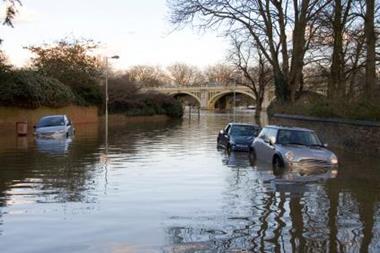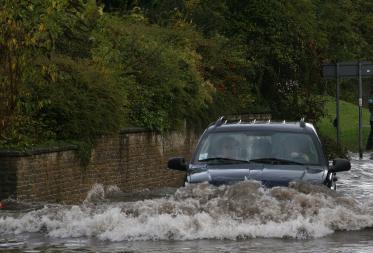Christmas marks a milestone for the thousands of people washed out of their homes by the summer flooding and still unable to return. The insurance industry claims to be in control, but for some the reality is different. Sarah Kennedy reports.
Dave Tomlinson’s Hull street is filled with caravans as far as the eye can see. The fact he isn’t alone in being forced into temporary accommodation is little comfort for the father of five. For the past six months Dave and his wife Lavinia and their children, all under the age of 10, have lived in a cramped 18ft caravan, despite documents from their insurer confirming they would be back home 12 weeks after the summer floods hit, and well in time for Christmas.
For many in the flood-ravaged areas, the merriment of the festive season is a distant dream this year. It’s challenging to deck the halls or whip together a turkey dinner when you’re living in a caravan.
The national media will fill its pages with such tales over the coming days, and will point the finger of blame squarely at the insurance industry. In anticipation of this, the Chartered Institute of Loss Adjusters (Cila) recently took the proactive step of issuing a statement on behalf of the industry on what has been accomplished so far.
Insurance Times decided to check on the true progress of repairing the damage and putting people back in their homes.
Tomlinson is one of 8,500 people still living in temporary accommodation following the summer’s devastating weather. He knew there would be flooding on 25 June, as the rain pounded down on the city. Many of the streets he travelled along on his way home from work were washed out.
But it wasn’t until later that evening when the water started streaming through the walls of his kitchen that he realised how severe the situation would get.
“I tried to put towels down, but the water just kept coming and coming,” he remembers.
He and his wife packed up their children, ages nine, seven, five, three and just one month, into the car and took them to a relative’s house as they began trying to mitigate the damage by moving valuables and electronics upstairs.
When the rain stopped, the Tomlinsons were left with eight inches of water in their house, and a kitchen and downstairs completely uninhabitable.
Within days, the extent of the flooding crisis was crystal clear. Forty eight thousand homes in the UK and 7,000 businesses were damaged, according to an independent review led by Sir Michael Pitt.
As insurers struggled to meet the demand of one of the largest floods in UK history, the Tomlinson family faced their own personal battle, piled into Lavinia’s mother’s one-bedroom flat, because no vacant hotels or rented accommodation could be found.
Tomlinson said for three weeks they tried to make the best of a cramped situation in the hope that they would be back in their home within 12 weeks as promised.
When it became clear that meeting the deadline was unlikely, the family moved into an 18ft touring caravan, which consists of one hallway, two bunk beds at both ends and a double bed with a baby’s crib at the side. The caravan, which was only partly subsidised by their insurer, cost several pounds of their own savings.
“In the summer the kids thought it was ‘
‘ fun. It was like an adventure and they played outside a lot. But now that it’s winter, we have to turn the heat on and the place fills with condensation,” he said.
Since then, Tomlinson has suffered a nightmare of frustration and delays with claims lost, mix-ups with contractors and miscommunication.
“It’s a bit of a nightmare. There’s not a lot of work that needs doing to turn this house around, but it has been left so long the house is damp again and a humidifier needs to be moved back in.”
While the Tomlinsons, their neighbours and thousands of other residents in Yorkshire, Gloucester and Oxfordshire, fled the floods, UK loss adjusters, travelled in droves into the depth of the destruction. For weeks, loss adjusters worked up to seven days straight, staying in rented accommodation, miles away from their families.
“Most loss adjusters liked the initial stage of being on the front line and helping people. They like to be out there with the muck and the bullets,” said Malcolm Edwards, president of Cila.
Loss adjusters spent the immediate aftermath trying to get to as many houses as possible and Edwards said the industry was justly proud of its record.
“During the early stages of the flooding aftermath – in one weekend loss adjusters visited 6,000 homes in the Yorkshire area,” he said.
At the same time, he added, loss adjusters were trying to keep an eye out for fraudulent claims, but also protecting policyholders from those looking to capitalise on their misfortune. Edwards cited cases where some contractors and accommodation providers heavily inflated prices in order to exploit the situation.
At the height of the action, many loss adjusters were so involved they had to be ordered to go home because companies feared burn out, added Edwards.
“It does impact on everyone’s working lives. There’s no doubt about that.”
Paul Hendy, flood recovery consultant and advisor for Hull City Council, agreed that the initial response by the insurance industry was brilliant.
“The first fortnight was the honeymoon period. But that didn’t last. There were 10,000 homes (in Hull) flooded and everyone wanted to be back in right away. It takes a good two to three months to dry a house and alternative accommodation had to be found, and in Hull there was a shortage,” he said.
The majority of victims hired or bought caravans with high expectations they would be home for Christmas, Hendy added.
“So now Christmas has become a major stress trigger. People are used to getting together with family in their homes but now everything that relates to family life is not there. You can’t cook a turkey dinner in a caravan.”
Hendy said research has shown, based heavily on experiences from the Carlisle flooding, that Christmas was a particularly stressful time for victims, particularly children.
“After Carlisle they were measuring the stress in the victims and children were asked at the time what they wanted for Christmas. Many of them said nothing because they were afraid the floodwater would only take it away again.
“We’re already seeing signs of trauma and stress with families. In Carlisle the floods came in January and the trigger came at Christmas. In Hull the floods came in June but the trigger is still coming at Christmas.”
Hendy said the situation has been compounded by cases of victims being assured early on in the flooding they would be moved back into their homes within several months, along with the frustration some are experiencing in trying to contact their insurers and loss adjusters.
He said some insurers had charged their policyholders fees for calling loss adjusters while others had only offered partial compensation for caravans and living expenses, putting many people into serious debt.
He admitted that due to the nature of his job, it was mostly complaints that he heard about the industry. He also said the flooding was an unprecedented event of catastrophic proportions and that loss adjusters were
trying their best to cope with the constant volume of calls.
He said: “I just don’t think [loss adjusters] had the numbers to deal with this volume of claims.”
With 165,000 claims, it was inevitable there would be some complications, said Justin Jacobs, head of property, motor and liability at the ABI.
Jacobs also acknowledged that because the summer floods were an unprecedented event with unforeseen problems, such as contractor shortages, and some companies might have underestimated the amount of time it would take to get people back into their homes.
However, he said insurers tried to be as open and realistic as possible.
“From our discussions with members, everyone said they are trying to give realistic timescales. We’d rather tell the truth up front than have them experience disappointment.
“Our ideal would be that there are no complaints, but with that amount of claims, it’s inevitable.”
In the aftermath of the flooding, the insurance industry spent a lot of time patting itself on the back for a job well done. And given the sheer scale of the crisis, insurers should be proud of their overall accomplishments.
According to the ABI’s statistics, 25% of flood victims are back in their homes and the number is expected to grow to 40% by Christmas. By mid-November, insurers had completed and paid out 65% of claims, totalling about £750m.
ABI director general Stephen Haddrill said: “The fact that insurance companies compete against each other, not just on price but on service as well, ensures that the industry as a whole was able to rise to this huge and unprecedented challenge, in many cases going to extraordinary lengths to provide the best possible service.”
But despite the best efforts of the industry, the ABI admitted that thousands still would not be home for Christmas, and that was a difficult reality for those who had worked so hard to settle the claims, said Cila’s Edwards.
“It’s difficult at this time of year. People do get frustrated and loss adjusters have to try to understand and empathise with people. For the most part people have been hugely understanding and have shown tremendous restraint.
“We accept the inevitability that you can only help so many people, but if the property is not dry, there is nothing you can do. Currently 90% to 95% of domestic properties are now dry. But now it’s a question of when the repairs can begin.”
Edwards said the problem had been worsened by a shortage of contractors – particularly electricians and plasterers.
He said it was paramount that loss adjusters continue to communicate with policyholders on the reasons behind the delays.
“All you can do is try anything you can to make their lives easier and manage their expectations,” he said.
Dave Tomlinson plans to move his family back into the upstairs of their home in time for Christmas, even through repairs won’t be completed until March.
He admitted that, frustrating as the situation has been for him, some in the community, such as his immediate neighbour who didn’t have insurance, were in far worse straits.
With no money to pay for immediate repairs or alternative accommodation, Tomlinson’s neighbour is currently living in his damp and flood damaged home, waiting for it to dry on its own and risking the dangers associated with mould.
“If you walk around the corner from me, every house has a caravan on the property,” said Tomlinson.“Someone said to me the other day, ‘you see it on telly but you don’t really realise how badly everyone was affected.’ He told me he’s never seen anything like it.”
According to the Pitt review, commissioned by the government to determine
lessons learned from the summer flooding, the damage could have been mitigated .
In his findings, Sir Michael Pitt found there was a need for stronger local leadership of flood risk management; clarification of roles; more co-operation between responsible organisations; better protection of infrastructure and wider and deeper public engagement.
The review’s interim results said most importantly the Environment Agency should undergo systematic monitoring of groundwater levels at times of high risk
and should begin right away to predict and mitigate further crisis this winter.
Immediately addressing the shortfalls on a national level would significantly help the UK deal with future flooding, Pitt added.
But for Tomlinson, the damage has already been done. “I don’t really know who is to blame. Do we blame the council for the drains being blocked, because that was the main problem? Other people say it was because of Yorkshire Water.
“Laying blame doesn’t really help me anyway.” IT



































